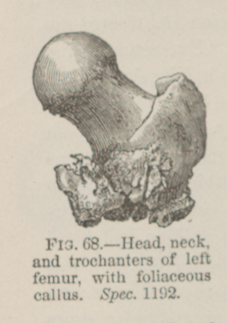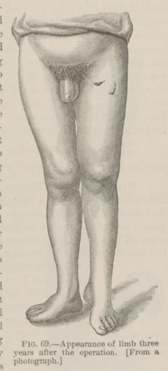Title: Brown, Joseph
Source text: The Medical and Surgical History of the War of the Rebellion. (1861-65.), Part 3, Volume 2 (Washington, DC: Government Printing Office, 1883), 113-114.
Civil War Washington ID: med.d2e6024
TEI/XML: med.d2e6024.xml
CASE 261.—Private Joseph Brown, Co. I, 3d Michigan, aged 38 years, was wounded at the second battle of Bull Run, August 29, 1862, by a musket ball, which passed through the left thigh, fracturing the femur just below the trochanter minor. He laid on the battle field three days, and was then removed to Centreville. On September 11, 1862, he was admitted to Fairfax Seminary Hospital, near Alexandria. The limb was kept in position by appropriate apparatus; but suppuration was profuse, and, on two occasions, fragments of bone were removed from the wound. Early in March, 1863, there was great swelling of the thigh, the discharge became scanty and fetid, and pus burrowed amid the muscles. On March 21st, an exploratory incision was made from three inches above to five inches below the prominence of the great trochanter. The neck and upper extremity of the shaft of the femur were found to be extensively diseased, and excision was decided on. Surgeon D. P. Smith, U. S. V., performed the operation. Difficulty was experienced in separating the muscular attachments from the trochanters, on account of the foliaceous masses of callus that had been thrown out. When this dissection was accomplished, many necrosed fragments were extracted, and the periosteum and new bone were separated by the handle of the scalpel and preserved as far as practicable. The shaft of the femur was then divided by powerful cutting bone forceps, about six inches below the tip of the great trochanter. A screw was driven into the mass of callus, below the trochanters, to be used as a lever in disarticulating the head, but it would not hold, and the bone was seized with large forceps and rotated, so as to facilitate the division of the capsular and round ligaments. The head, neck, and trochanters, and the masses of callus adhering to the trochanters, were then removed. The operation was accomplished with but very trifling hæmorrhage, yet great prostration followed, and the patient rallied slowly. As the anæsthesia passed off, he had much nausea and vomiting. As soon as this subsided, he was given a very full allowance of concentrated nourishment, such as strong beef-tea, eggs, milk, etc, with half an ounce of brandy every two hours. The wound was partially closed; the limb was supported on pillows until the third day, when it was dressed in a Smith's anterior splint. About forty-eight hours after the operation, an erysipelatous blush pervaded the limb, and the constitutional symptoms assumed a typhoid character. A female catheter was passed through the middle of the wound and another at its lower extremity, through which much offensive decomposed serum and grumous blood escaped. The wound was thoroughly washed out through the catheters with warm water impregnated with chlorinated soda. On the fifth day there was a rigor, and hæmorrhage to the extent of six ounces. As the anterior splint did not permit convenient access to the limb, it was removed, and the leg and thigh were suspended in a canvas hammock, the leg being horizontal and the thigh in an almost vertical position. A piece of soft toweling extending from the perineum to the popliteal space, and, connected by cords with an upright post at the head of the bed, supported the muscles on the sides and under surface of the thigh. The wound freely discharged synovia, bloody serum, and thin pus, until the seventh day, when healthy suppuration was fairly established. During April, 1863, the patient's progress was satisfactory. He was supplied with very nutritious diet, with porter, and cod-liver oil. He took for a time as much as a half a pint of oil daily. During May, the case continued to progress favorably. It was necessary to keep a tube in the wound until June 1st. Previously, whenever it was removed pus would accumulate and burrow. A mesh of suture wire was finally substituted for the tube. This was retained until June 20th, when the patient began to get about on crutches. In the latter part of July the wounds closed. In August, Brown was reported as "well," and on August 23, 1863, he was discharged from the hospital and from the military service of the United States. On March 21, 1864, he wrote from his home in Coopersville, Michigan, that his health was good; that he could get about and attend to home business; could saw and split a little wood for fuel, though his knee was stiff and his leg painful. On the whole, there had been steady improvement. In September, 1865, he again wrote, and stated that his general health was good; that he had some control over the movements of the thigh, being able, when standing on the right foot, to swing the left backward and forward, and to adduct the thigh enough to carry the injured limb across the other. He could bear some weight on the limb, and use but one crutch, with a stirrup for the foot. There had been no fistulous orifices since March 1864, and there was no soreness about the cicatrices. In November, 1865, in accordance with a request from the Surgeon General's Office, Mr. Brown had a photograph (FIG. 69) taken to represent the amount of deformity in his limb. This picture is numbered 110 in the Photograph Series of the Army Medical Museum. It is carefully copied in the accompanying wood-cut. The excised bone is preserved at the Museum, and is numbered 1192, Section I. It is represented in the adjacent wood-cut (FIG. 68). On February 12, 1868, he wrote to the compiler of this report: "I take pleasure in informing you that my limb is in as good condition as when I last wrote you; but think there is no improvement, except that it is not as tender. There have been no abscesses, nor any pain in the limb, excepting slight pains about the knee, just before storms. About two years ago, I slipped and fell upon the ice, injuring the limb severely about the knee, and was thereby confined to the house for about three weeks. In March last I had a severe attack of ague. The limb swelled quite badly at this time, and was much inflamed for about ten days. I applied cold water and a bandage to reduce the swelling. I had to keep it bandaged about two weeks after the inflammation was removed. Since that time the limb has given me no more trouble than usual. Since I was discharged I cannot see that there is any lengthening of the limb. I have to use a crutch and cane all the time when moving about, and I think I shall always have to do this. The injured limb has wasted away somewhat since I last wrote. The circumference of the well limb at the upper extremity is 22 inches, and the injured limb measures at the same place 19½ inches. The knee of the well limb measures around the centre of the knee-pan 15½ inches; the injured limb measures at the same place 17 inches. The above measurements were made in the evening; I think that in the morning the measurements of the injured limb would be less. The knee still remains quite stiff, and gives me about all the pain there is anywhere in the limb. I have been troubled during cold weather by coldness of the outer side of the leg, and I have to warm it by the fire before going to bed nearly every night when I have been out." On November 19, 1868, another letter was received from Mr. Brown, from which the following extract is made: "I take pleasure in informing you that my limb is in as good condition as it has been at any time since it was entirely healed, and, if anything, in better condition. It does not pain me about the knee as much as it did one year ago. It does not have any spell of swelling at the knee as it did for the first two years after my discharge, and there is less soreness about the limb than there was even one year ago. I can get around without hurting it as much as formerly. I can bear some weight upon it. I have walked across a room without the aid of crutch or cane, by stepping very quick with the well limb; but it is more like hopping than walking. There have been no abscesses in the limb. I think that it is gradually improving, and hope that I may yet see the day that I can go without a crutch. My general health is good. I have not been sick a day for a year and a half, and then only a few days with ague. My weight now is 167½ pounds. Before I entered the army my weight was never quite up to those figures, but within a few pounds of it. I have been postmaster at this office over a year, and have attended to all the business of the office almost entirely without assistance, and it gives me pretty good exercise." On September 6, 1875, the date of his last examination for pension, the Grand Rapids Examining Board stated: "There is now a false joint with shortening of the limb." Since then this pensioner has been exempted from further surgical examinations. He was paid September 4, 1877, remaining in comparatively good health more than fourteen years after the operation.

